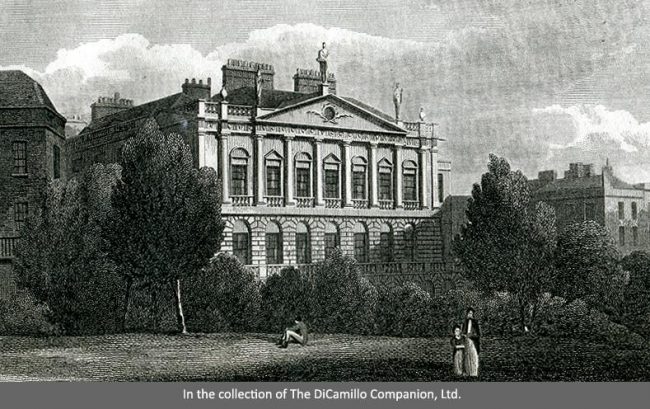
An 1815 engraving of the house from "The Beauties of England and Wales"
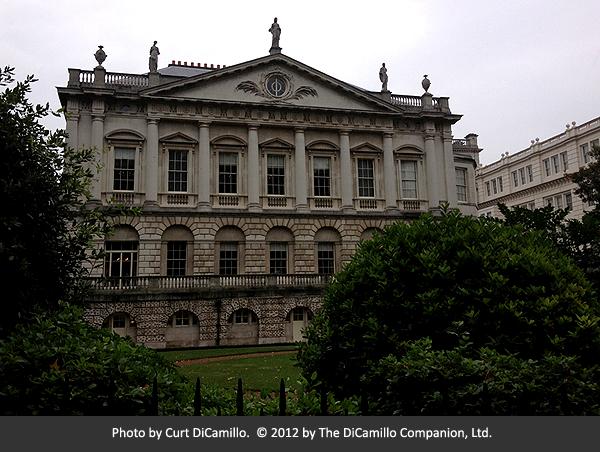
The house from Green Park, with Bridgewater House to the right.
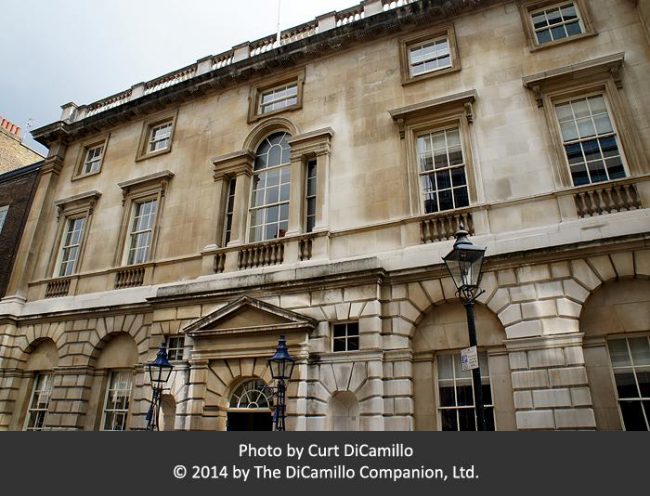
The entrance facade
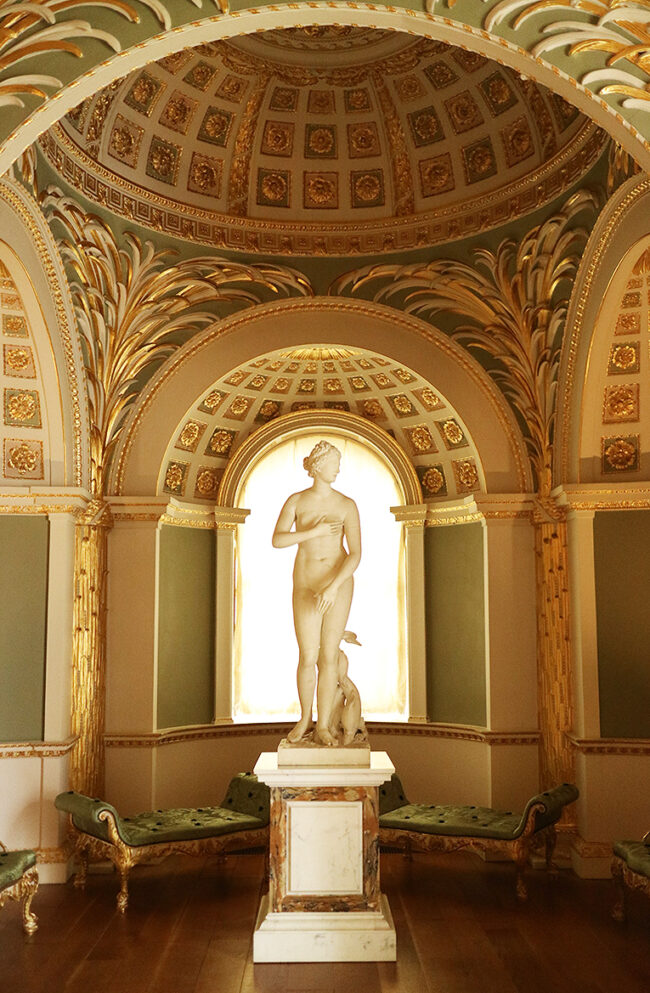
The Palm Room. Photo by kind permission of Edward Allgeyer.
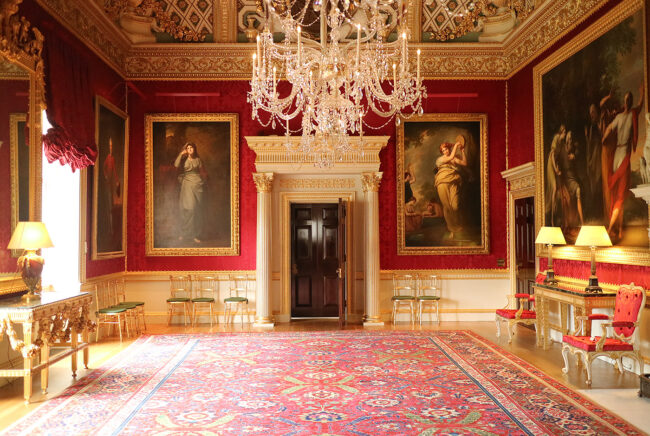
The Great Room. Photo by kind permission of Edward Allgeyer.
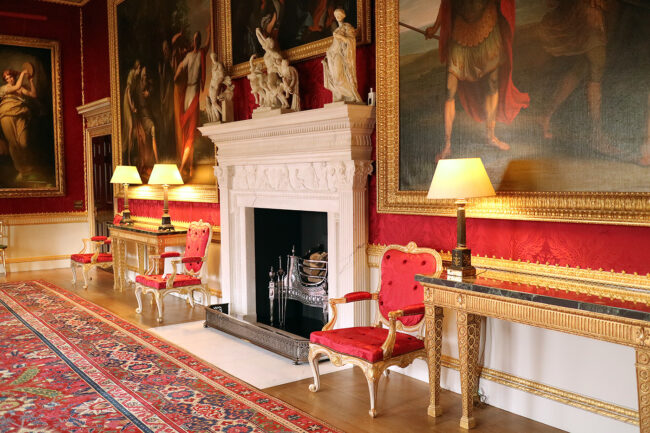
The Great Room. Photo by kind permission of Edward Allgeyer.
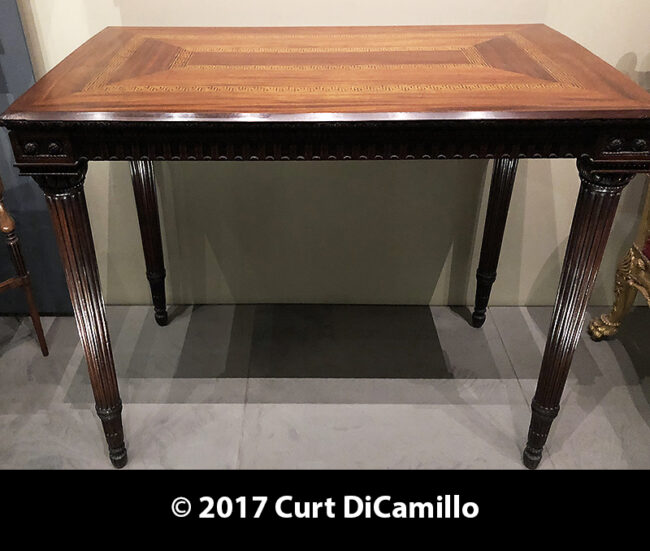
Circa 1760 Neoclassical table designed by Athenian Stuart for Lady Spencer's Bedroom, today in the collection of the V&A.
Built / Designed For: 1st Earl Spencer
House & Family History: Spencer House was started in 1756 by John, 1st Earl Spencer (fourth paternal great grandfather of Diana, Princess of Wales). Lord Spencer was the grandson of the 3rd Earl of Sunderland and the great-grandson of the 1st Duke of Marlborough; the 1st Earl inherited both of these fortunes while still a young man. At a ball at the family's seat of Althorp, he secretly married his sweetheart, the 18-year-old Georgiana Poyntz. Their daughter, also named Georgiana and famed for her beauty, married the 5th Duke of Devonshire (chronicled in the 1999 book "Georgiana: Duchess of Devonshire," by Amanda Foreman, which was made into the 2008 movie "The Duchess"). Their younger daughter, Harriet, was the 3rd Countess of Bessborough; she was the subject of Janet Gleeson's 2006 book "Privilege and Scandal: The Remarkable Life of Harriet Spencer, Sister of Georgiana." The Spencer family stood at the pinnacle of 18th century society and were one of the most powerful families in the land. The family fortune was founded in sheep farming in Wormleighton, Warwickshire; by the time the time of the 1st Earl the Spencer estates spanned 100,000 acres and brought the earl an annual income of £35,000 (approximately £61 million in 2012 values using the labour value commodity index). Their family seat of Althorp in Northamptonshire was purchased in 1506; 100 years later James I created them barons Spencer; Charles I elevated them to earls of Sunderland. The 1st Earl Spencer initially engaged John Vardy as the architect for his new London palace; however, in the fall of 1758, James "Athenian" Stuart replaced Vardy, who ended up only designing the external elevations of the house and the ground floor rooms, including some of the furniture (much of the carved decoration in wood and probably some of the furniture was produced by Vardy's brother, Thomas). Stuart designed the nine staterooms' Neoclassical interiors; the Painted Room is his most complete surviving work and shows his great talent as a painter. This astonishing room was begun circa 1759 and was completed in November of 1765 and is considered the first fully integrated Neoclassical interior in England, and possibly in Europe. Its strong classical design was the predecessor of the many Etruscan and Pompeian rooms that followed in Britain and Europe. Spencer House was also the first example in London of accurate Greek detail in interior decoration. William Kent based his design for the Statue Gallery at Holkham Hall on the famous ruins of the Temple of Venus and Rome in Roma, a design element that John Vardy used in the Ante Room at Spencer House (it also makes an appearance at Chiswick House). The magnificent marble chimneypiece in the Great Room features a frieze inspired by the Choragic Monument of Lysicrates in Athens; a very similar fireplace is in the saloon of Lichfield House (15 St. James's Square). Spencer House, whose principal façade overlooking Green Park is of Portland stone, took over seven years to build and cost almost £50,000, a staggering sum in the 18th century (equivalent to approximately £94 million in 2014 values using the labour value commodity index). Among the first people to see the new house was Arthur Young, who said "I know not in England a more beautiful piece of architecture...superior to any house I have seen..." Right from the start Spencer House was acknowledged as one of the most ambitious private palaces ever built in London; it continues in that tradition today as the only great 18th century London townhouse to survive intact. The 2nd Earl Spencer engaged Henry Holland to modernize Althorp and to update Spencer House. Holland created a new Library, redid the Ante Room (Parlour), and redecorated Vardy's Dining Room, where he faced the Ionic columns in scagliola. In the 1840s the 4th Earl hired Philip Hardwick to refurbish Spencer House. Hardwick's work included the installation of modern services, plate glass in the windows, and the decoration of the ground floor rooms in gold and scarlet. The 5th Earl was in a tight financial position and thus leased Spencer House to a number of tenants from 1895 until 1910. The 6th Earl, upon inheriting the title, moved back into the house. It is largely due to the efforts of the 7th Earl, however, that Spencer House did not fall to the fate of so many of its neighbors and come under the wrecking ball. The 7th Earl was a cultivated man, prominent in the world of museums, and a frequent contributor to "Country Life" magazine, where he wrote about Spencer House. The earl was passionate about Spencer House, and, though unable to afford to live there himself, he redecorated the entire house in 1926 (the doorcases in the Great Room may have been designed by him). The house was leased to the Ladies' Army and Navy Club from 1927 until 1943. During the worst of the London Blitz, the 7th Earl decided that the fittings at Spencer House were unsafe in London and he settled on moving them to Althorp; by the evening of May 12, 1941 all the architectural treasures (chimneypieces, doors, skirting moldings, chair rails, and architraves) had been loaded into vans and were on their way to Northamptonshire, where they remain today at Althorp. During the war a high explosive bomb fell on neighboring Bridgewater House – it demolished the stables of Spencer House and destroyed windows along the south and west facades of the house and did particular damage to the ceiling of the Painted Room, which was completely restored after the war. In January 1943 the government authorized the removal of the original 18th century gates on the terrace to be used as scrap. During the latter part of the war, Spencer House served as the nation's nursing services central office. When World War II finally ended, the house was in a state of "utter dereliction." The architects Robert Atkinson & Partners repaired the house and soon thereafter Christie's signed a lease to use Spencer House as their headquarters while their own bomb-damaged building was repaired. In 1956 the British Oxygen Company took over the lease, together with that of Bridgewater House, using both houses as their headquarters. During this time the Great Room had floor-to-ceiling partitions to enable it to serve as offices. British Oxygen vacated in 1962 and in 1963 the Intelligence Unit of "The Economist" magazine moved in; when they left the house in 1985 there was considerable speculation about the future of Spencer House; "The Times" reported that the National Trust was interested in the building as its new headquarters; the Getty Museum purportedly expressed an interest in taking over the house to exhibit works of art that it would purchase that would be blocked for export to the United States. After all the talk settled down, the 4th Lord Rothschild, and his associated companies, acquired the lease and began the painstaking restoration that has raised Spencer House to new heights. Lord Rothschild engaged the architects Rolfe Judd, who began restoration in the summer of 1987 and completed the job by the end of 1989. It was decided to restore the house to the condition it appeared after Holland's work of the 1780s-90s. The back wings were reconstructed and rebuilt to provide modern-style offices, while the original external elevations of John Vardy's design were restored. The principal rooms were all restored and their missing architectural detail painstakingly copied from the originals at Althorp. The small inner courtyard was recreated, providing a wonderful new space for entertaining.
Collections: Spencer House in the 18th century was a treasure trove of art; Lady Spencer's dressing room alone was hung with masterpieces by Poussin, Leonardo, Veronese, Titian, and Rubens. By 1728 Sir Robert Furnese, 2nd Bt. (died 1733), owned Andrea Sacchi's "Apollo Crowning the Musician Marcantonio Pasqualini," which was once owned by Pope Clement IX. The painting remained at Sir Robert's seat, Waldershare Park, until it passed to his cousin, Henry Furnese (first lord of the Treasury, died 1756), at Gunnersbury. After Henry's death in 1756 the painting was purchased by the 1st Earl Spencer (1734-83), who hung it in the Great Room at Spencer House (the painting was sold by the New York City dealers Wildenstein & Co. in 1981 for £270,000 to the Metropolitan Museum of Art). Lord Spencer used Guido Reni's "Liberality and Modesty" (which had a frame designed by James "Athenian" Stuart) as a pendant painting for the Sacchi. The Reni was also purchased by the 1st Lord Spencer from Henry Furnese's estate and remained in the Spencer collection until 1979, when it was sold by the 8th Earl Spencer to Wildenstein & Co., from whom it was purchased by the American collector Peter Sharp; after Sharp's death Sotheby's sold the Reni in New York on January 13, 1994 for $618,500. Significant pieces of furniture designed by Athenian Stuart for Spencer House were sold to the Victoria & Albert Museum; one of these, a circa 1760 mahogany and boxwood-inlay table (see "Images" section) that was made by an unknown London cabinetmaker for Lady Spencer's bedroom features Doric capitals on its legs copied from the Erechtheum. Much of the furniture from Spencer House is today at Althorp, the Spencers' Northamptonshire seat, with a small amount at Kenwood House, London. Two of the original chairs from the Palm Room at Spencer House (probably made by Thomas Vardy, brother of the house's original architect, John Vardy) have been in the collection of the Museum of Fine Arts, Boston, since the 1960s, where they are among the most important examples of mid-18th century English furniture in an American museum (the carver Thomas Vardy was at the top of his field, with few equals in 18th century London). The 2nd Earl Spencer was a great bibliophile; his library, including 58 Caxtons, is now at the John Rylands Library in Manchester. The Marlborough ice pails, a pair of solid 22-karat gold ice pails, cylindrical in shape with lion mask handles, were made for the 1st Duke of Marlborough and sold by the 8th Earl Spencer to the British Museum in 1982. The two pails together weigh approximately 25 pounds (365 ozs 6 dwts Troy) and are the only surviving English examples made of pure gold. They are very likely unique, as no other gold ice pails from the late 17th or early 18th centuries are documented in Britain or abroad. As is generally found with English gold plate of the period, the pails were not hallmarked and carry no date letter; however, it's very likely they were made in London circa 1700, probably by a Huguenot goldsmith (Huguenot craftsmen were noted for their work in gold plate). David Willaume is frequently mentioned as a possible maker; he was a Huguenot working in London at the right time, and he made the earliest known pair of ice pails: in silver in 1698 for the 1st Duke of Devonshire. Upon her death in 1744 at the age of 85, Sarah, 1st Duchess of Marlborough, one of the richest women in Europe, left the ice pails, together with much else, to her favorite grandson, John Spencer (1708-46). The pails remained Althorp, where they descended upon the earls Spencer in direct succession until the sale in 1982 by the 8th Earl. Sold at Christie's London on July 8, 2010 were 70 lots of art, porcelain, and furniture at Althorp removed from Spencer House, which brought a total of £4,857,750. The star pieces were a pair of George II open armchairs made of limewood and sabicu (the very hard wood of a leguminous West Indian tree). The chairs were very probably designed Athenian Stuart for the Painted Room at Spencer House; they sold for £802,850.
Architect: Henry Holland
Date: 1785-92Architect: Philip Charles Hardwick
Date: 1840sArchitect: Rolfe Judd
Date: 1987-89Architect: Robert Atkinson
Date: Late 1940sArchitect: John Vardy Sr.
Date: 1756Architect: James Stuart
Date: 1758-65Country Life: LX, 660, 698, 757.
Title: Sotheby's Auction Catalog: The Estate of Peter Jay Sharp, Jan 13, 1994
Author: NA
Year Published: 1994
Reference: Item 73
Publisher: New York: Sotheby's, Inc.
ISBN: NA
Book Type: Hardback
Title: Privilege and Scandal: The Remarkable Life of Harriet Spencer, Sister of Georgiana
Author: Gleeson, Janet
Year Published: 2006
Reference: pgs. 3, 5
Publisher: New York: Three Rivers Press
ISBN: 9780307381989
Book Type: Softback
Title: London, 1753
Author: O'Connell, Sheila; Porter, Roy; Fox, Celina; et al
Year Published: 2003
Reference: pg. 207
Publisher: Boston: David R. Godine, Publisher
ISBN: 1567922473
Book Type: Hardback
Title: Biographical Dictionary of British Architects, 1600-1840, A - SOFTBACK
Author: Colvin, Howard
Year Published: 1995
Reference: pg. 503
Publisher: New Haven: Yale University Press
ISBN: 0300072074
Book Type: Softback
Title: Georgiana: Duchess of Devonshire
Author: Foreman, Amanda
Year Published: 1998
Publisher: New York: Random House
ISBN: 0375502947
Book Type: Hardback
Title: Treasures of the British Museum
Author: Caygill, Marjorie
Year Published: 1985
Reference: pgs. 172, 174
Publisher: New York: Harry N. Abrams, Inc.
ISBN: 0810916878
Book Type: Hardback
Title: Spencer House Guidebook
Author: Robinson, John Martin (Text); Jones, Stephen (Editor); Rick, Jane (Editor)
Year Published: 1996
Reference: pgs. 1, 2, 3, 4
Publisher: London: Philip Wilson Publishers Limited
ISBN: NA
Book Type: Light Softback
Title: Spencer House: Chronicle of a Great London Mansion
Author: Friedman, Joseph
Year Published: 1993
Reference: pgs. 74, 75, 102, 180, 275-279, 289
Publisher: London: Zwemmer
ISBN: 0302006176
Book Type: Hardback
Title: Country Life Cumulative Index: Volumes I to CXCIII to December 1999
Author: NA
Year Published: 2000
Publisher: London: IPC Magazines Limited
ISBN: NA
Book Type: Light Softback
Title: Disintegration of a Heritage: Country Houses and their Collections, 1979-1992, The
Author: Sayer, Michael
Year Published: 1993
Reference: pg. 151
Publisher: Norfolk: Michael Russell (Publishing)
ISBN: 0859551970
Book Type: Hardback
House Listed: Grade I
Park Listed: No Park
Past Seat / Home of: John Spencer, 1st Earl Spencer, 1766-83; George John Spencer, 2nd Earl Spencer, 1783-1834; John Charles Spencer, 3rd Earl Spencer, 1834-45; Frederick Spencer, 4th Earl Spencer, 1845-57; John Poyntz Spencer, 5th Earl Spencer, 1857-1910; Spencer family here from 1760s until the early 20th century.
Current Ownership Type: The Crown / Royal Family
Primary Current Ownership Use: Mixed Use
Ownership Details: The freehold is owned by the Crown Estate; the leasehold was acquired by the J. Rothschild Group of companies in 1985 through Spencer House Limited. Primarily used as an event and conference venue; open to the public on Sundays.
House Open to Public: Limited Access
Phone: 02075-141-958
Email: [email protected]
Website: https://spencerhouse.co.uk/
Historic Houses Member: No